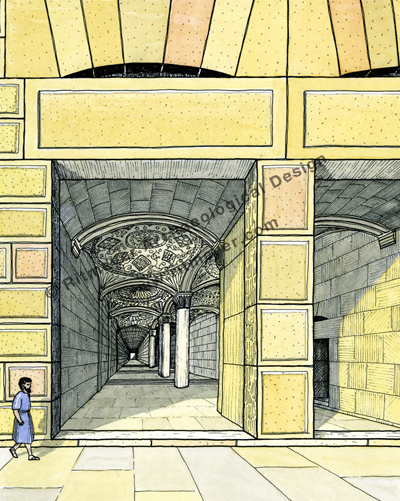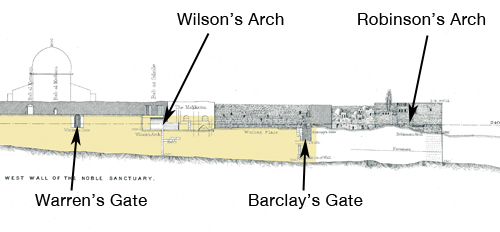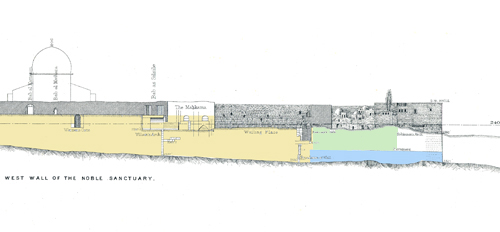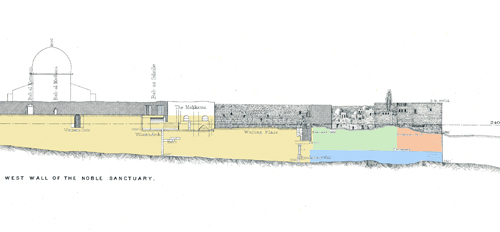The latest archaeological developments near the Western Wall of the Temple Mount (see my previous post) have caused concern to some who feel that their understanding that King Herod the Great built the Temple Mount in Jerusalem is being undermined. It would mean that the Temple Mount was not finished when Jesus visited the Temple. That, however, does not have to be the case.
It took several decades to complete this massive Temple Mount. I will always call it Herod’s Temple Mount, as he was the originator of its plan and began its construction. Todd Bolen pointed out in his latest blogpost: “Josephus reported that in AD 64 work was halted on the Temple Mount and 18,000 workers were laid off (Ant. 20:219-23).” Such large projects take a long time to complete. It was started in the reign of Herod the Great, but continued during the time of his sons and grandsons. It is possible that the Temple Mount was never totally completed.
The problem of how and when the Temple Mount walls were built is very complex. There are architectural features that indicate that the Temple Mount walls were built in stages over a considerable period of time, although within a time span of less than 100 years. I don’t as yet have all the answers, but focussing on the Western and Southern Walls, the following points need to be taken into consideration:
1. The south end of Robinson’s Arch is keyed into the stones of the Western Wall, but its northern end is NOT:

This means that, at some stage, the upper part of the Western Wall was built from a point to the north (possibly Wilson’s Arch) to the location where they planned to build Robinson’s Arch (see the straight joint in the drawing on the left). The arch and perhaps the southwest corner must have been built later (see The Quest – Revealing the Temple Mount in Jerusalem, p.46). This means that in 20 AD (see previous post), the southern part of the Western Wall was not yet completed.
2. However, this would leave enough time (10 years) for the southern part of the Temple Mount to be finished by around 30 AD, when Jesus and his disciples visited the Temple.
3. The street complex below Robinson’s Arch was built later (perhaps 50 AD), as coins from the time of Agrippa II were found below the paving stones.
4. The stones of the Western Wall below Robinson’s Arch have rough bosses below street level. That is also the case near Barclay’s Gate, but not to the north of this gate. The stones of the Southern Wall, from the southwest corner to the Double Gate have also rough bosses below street level, but they don’t appear in the east part of the Southern Wall. Warren wrote (Survey of Western Palestine, Vol II, Jerusalem, p. 191):
“From the two shafts sunk at Wilson’s Arch and at Barclay’s Gate, it is obvious that the Sanctuary wall is for this portion built up from the bottom with drafted stones with well-cut faces. But to the south of the retaining wall at Barclay’s Gate, at the south-west angle and round the south-west angle to the Double gate, the stones have rough projecting faces up to the level of the pavement under Robinson’s Arch, that is, up to Course P, or to about 23 feet 6 inches above the rock at Barclay’s Gate, the sill of the gate being about 50 feet above the rock. From this the inference may be drawn that the wall south of Barclay’s Gate is of later date that that to the north, and was not commenced till the valley had begun to fill up about 23 feet 6 inches at this part. In this case the retaining wall may have been one side of a ramp or viaduct leading across the valley to this Suburban gate, at a height of 27 feet above the surface of the ground at that time.”
5. Two fallen voussoirs are lodged in the drain below Robinson’s Arch, showing that part of the arch fell down during its construction (see pictures in this previous post).
6. The two eastern domes of the Double Gate passageway (barely visible on the right in the drawing below) also fell down at some time during the First Century AD and were built up again without decorations. (The western domes are still decorated). It is not clear if this happened before or after the Royal Stoa was completed.

At present, I see the following sequence in the building of the southern part of the Temple Mount (only four of the stages are illustrated below):
a. Herod, in his lifetime, completed the lower part of the Western Wall from the Antonia Fortress up to Barclay’s Gate, that is as far south as the Hasmonean extension of the square Temple Mount goes (see this previous post). The portico on top of the wall may only have been completed from the Antonia up to the gate over Wilson’s Arch, as that is where the First Wall was connected to the Temple Mount.

b. The part of the Western Wall that lies below the street, from Barclay’s Gate up to the southwest corner and then up to the Double Gate in the Southern Wall, was built with rough bosses in or soon after 20 AD. Because the southwest corner of the Temple Mount crossed the Tyropoeon Valley and cut the drain below the planned street, an arched relay section was built to connect the drain again. The Western Wall with the rough bosses was built up to the level of the planned street:
c. The Tyropoeon Valley was then (20 AD), filled up to the level of the rough bosses from Wilson’s Arch to Barclay’s Gate.
d. The top of the Western Wall was built from the gate over Wilson’s Arch to the north side of Robinson’s Arch:

e. Robinson’s Arch and the Double Gate in the Southern Wall with the wall in between were built later, possibly sometime around 30 AD.
f. Part of Robinson’s Arch fell down (and perhaps also Wilson’s Arch) and the two eastern domes of the Double Gate passageway were destroyed (The Quest, p. 74) – possibly by an earthquake?
g. The underground passageway of the Double Gate was repaired, the southwest corner with Robinson’s Arch and stairway completed and the Royal Stoa finished.

This proposal for the development of the Herodian Temple Mount is only in its early stages, but I hope that it may be helpful to those who struggle to understand the implications of the latest archaeological discoveries near the foundation of the Western Wall.
© Leen Ritmeyer

Leen – this is excellent. Thank you for all of your work in putting it together.
Todd – glad you find it useful. Your post was incisive and spot-on.
I don’t believe the second stage image is being displayed correctly on the web page. It would be great to see it.
Thank you for this great article.
Dean – Don’t know what is the problem. It appears correctly on my screen.
Dear Leen,
Thank you for your posts. Much was new to me.
One question: you imply that south of Barclay’s Gate, the stones below the street level have rough bosses. I recall that in the mid-1980’s we stood in the Mazar excavations between that Gate and Robinson’s Arch, and you pointed into a narrow vertical shaft showing the dressed stones of the wall going deep down (below street level?). Here you raised the question as to why Herod would have used dressed-stones below the street, where they would not have been visible. You suggested that perhaps he had originally planned the street at a lower level, had then disliked the outcome and had raised it. Granted, much more information has become available since, and this is reflected in your work. But what about the dressed stones we saw back then between Barclay’s and Robinson’s? Were they not below street level, after all? Or is my memory playing me false?
Dear Steve, you have a good memory! At the point in question, there are four stone courses to be seen below the Herodian street level (out of a total of nine). You must remember, of course, that the street level at that point is about 2 meters higher than at the southwest corner. The lowest visible stone in the excavation, however, is located at about the same level as where the stones with rough bosses start going down below the Herodian street level at the southwest corner. It appears therefore that the top of the stone courses with the rough bosses were laid at a uniform level, above which the stones with the smooth bosses were built. The foundation walls for the shops along the Western Wall go down to this level too. It would have been more difficult to build these cross walls against stones with rough bosses. So, if you think horizontally, there appears to be some method in the apparent madness of burying beautifully carved stones below the street.
how would u explain the finding of לבית התקיעה לה[הכריז] י which indicates that the south west corner was built and functioned b4 destruction of the temple?
Eli,
In that post I commented on a possible construction sequence of the Western Wall, especially in the wake of finding coins from 17-18 CE. The sequence is still plausible, but within a shorter time span. In reply to a comment I noted: “Actually the coins prove nothing at all, as the mikveh only project a few centimeters under the wall. The coins came probably from a later repair. The Trumpeting stone was found lying on the Herodian pavemant and is part of the destruction of the Temple Mount in 70 CE.” I now believe that the Southern Wall with the Royal Stoa and the Trumpeting Stone were all completed in Herod’s life time, for none of his successors would have had the financial and political means to such an ambitious and expensive project as the Royal Stoa.